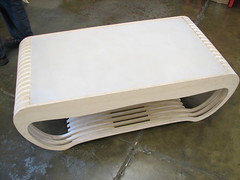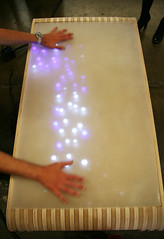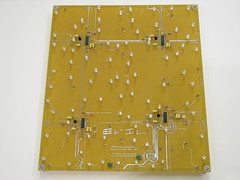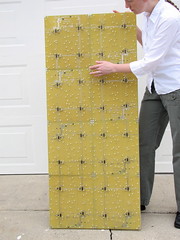Last year at Maker Faire, we showed off our interactive LED dining table. There, we met the fine folks at Because We Can, who make amazing mostly wooden things with a little help from their robot. We eventually all decided on collaborating to design and build a new series of interactive coffee tables. We’ve just wrapped up the project and are introducing them this weekend at Maker Faire.
Besides what is written about them on this page, you can read more about them on the
Because We Can Blog, and you can also see lots of photos in the product pages for the two different coffee table designs: the wave and the ripple.
The new tables are designed to look really great whether or not you can see the LEDs. The wooden bases are elegant and attractive, and also if you go up to one and touch it, it will respond by pleasantly lighting up in that area. The tables are designed to respond in a subtle and gentle fashion to stimulus provided by human interaction. They are normally dim and constant– the most you’ll see in a dark room is a faint glow of twinkling like the night sky. When you set your glass down on the table, however, the table “sees” the motion that induces a slow ripple starting in that location that spreads out to other areas of the table as it dissipates. The overall effect is a bit like touching a pool of water, in that your local disturbance turns into an overall gentle rippling, and eventually settles down. It is decidedly not a disco floor– there is no blinking, no programmed oscillations, or for that matter, any digital electronics at all– the circuitry is completely analog to improve aesthetics and reduce eyestrain.
If you saw our interactive dining table last year at the Maker Faire, you might have noticed how it responds to motion. That table has a network of strictly passive light sensors that is able to detect changes in ambient lighting. So these sensors would respond to any changes in lighting in the room, and so would have the state changed by the position of shadows landing on the table’s surface. The new tables are also sensitive to shadows (from incandescent sources), but also incorporate an array of infrared LEDs that allow the table to respond the same way even in pitch-black conditions.
The algorithm implemented by the new tables is also quite different from those on the old design. The old table has 448 multi-colored LEDs that are arranged in banks of 14. At any given time half of the banks of 14 could be either fully or partially on and by interacting with the table you can, in a non-obvious way, affect which banks are on at a given time. The exact behavior was intentionally obfuscated in order to give the table an organic and non-obvious feeling almost as though it were alive and thinking about what it should do in response to you. By contrast, we wanted the new tables to have all of their LEDs essentially off when no one is interacting with the table or its environment is still. When a given node senses a change in the light conditions above it, it triggers its two banks of 10 super bright LEDs to turn on in the pattern of a damped sine-wave where one bank of 10 represents positive values of the sine-wave and the other negative. In non-mathematical terms, that means that touching an area leads to a rippling affect of the LEDs surrounding that point. After a few cycles of the ripple, you can begin to see the ripple spread to neighboring sites and the ripple dissipates across the table surface over the course of a minute or so.
The active surface of the interactive coffee tables is an array of printed circuit board panels that sits beneath the visible surface of the table, whether that is a clear or frosted glass or acrylic top. The circuit board panels are 12 x 14 inches and are the same ones that we we wrote about laying out with open source tools a few weeks ago. Each panel has four network nodes (each with its own infrared photodiode) and supports 80 super bright LEDs. The boards are symmetric in their connections and can be wired up in any configuration where the individual boards line up edge to edge. If needed, they could also be connected by long wires leading to distant but connected boards for a network of interconnected cocktail tables, for example. In the photo here is the array of boards for one of the two coffee tables that we have made. It is a two by four array with total dimensions of 24 by 56 inches. Altogether it is a *very large* circuit board. In order to try out a variety of possible styles that you might build shapes around these circuit boards, we made two very different interactive coffee table prototypes with very different CNC machined bases. To contrast them, one has all white LEDs while the other has a mixture of half blue and half white super bright LEDs. We built one with a clear top and the other with an acrylic top sanded on both sides. This gives an almost magical effect because you cannot see the LEDs or circuit boards whatsoever. In fact, if no one has disturbed the table recently you would never guess that there is anything electronic or interactive about the table.
There is a photo set where you can see many more pictures of the tables. Better yet, you can actually come to the Maker Faire and try them out for yourself. These tables are also now available for purchase online through Because We Can; take a look here for one version and here for the other. We also made a flyer that says most of this in a printable format (460 kB PDF).









No video? The animated GIF on their site doesn’t count.
Pricey. I hope you sell a bunch, though. Can you share anything about how you’re communicating between boards in an analog manner?
I don’t know if you’ve found it yourself yet, but there’s a funny problem with photographing LEDs: your eyes have a much larger dynamic range than the sensor in the camera. That’s a very strange thing, because when LEDs turn on *just a little bit*, you can’t tell that apart from when they are on *all the way* either in still photos or in the video. While that’s bad for still photos, it really ends up making video misleading. Where your eyes see a smooth transition between two lights being on, you just see an annoying-as-hell BLINK-BLINK. If you record a video of the table and play it back right away, you can clearly see that it doesn’t reflect what the table is doing. It’s totally weird.
I suspect that using actual movie *film* would solve the problem, but I haven’t seen the solution for digital video yet. One thing that I’m going to try is stopping down the aperture so that you can’t see the tables themselves anymore– that might leave the dynamic range a little more appropriate for video, but we’ll see.
The tables are indeed pricey, but they are worth it. ;) I’m sure that it will be no surprise to you, but the expensive part of handmade furniture is labor costs related to woodworking. Go estimate how low of a price you *possibly could* have custom tables like these made for, and you’ll come up with a similar number.
—
Windell H. Oskay
drwho(at)evilmadscientist.com
http://www.evilmadscientist.com/
Yes, I’ve made my own furniture, so I understand that it is a time consuming matter to make anything that’s not mass produced.
Film may be better, but it would depend on the film. Transparency film (the classic slide) generally has the smallest exposure latitude of films, and it’s fairly close to that of a digital camera. But I’ve only worked with still camera film, not movie camera; I’d have to ask a friend. Digitizing film stock is then another difficulty; the cheap and common way to do it is to just project it and record the projection, which wouldn’t gain you anything in the end. The more proper way is to scan it frame by frame, which is more expensive and time consuming. I doubt there’s a ROI on satisfying my curiosity.
It’s a pity they don’t put exposure latitude data on digital/DV cameras. It has to vary some from CCD to CCD.
Thanks for the replies, and again, nice work.
Sorry– forgot to answer one of your questions. The circuit is fully analog, so the communication between the parts is just sending a voltage over on a wire.
—
Windell H. Oskay
drwho(at)evilmadscientist.com
http://www.evilmadscientist.com/
Dear evilmadscientist.com,
Perhaps you could contact us about becoming distributors/resellers of your table?
I help run a science/art-oriented bookshop DARK CARNIVAL in a tiny wealthy cranny of Berkeley CA. We’re near a shop specializing in wooden livingroom furniture [only "arts&crafts-style" antiques.] We have a large extra display window that’s often not updated. Educated well-heeled and imaginative people keep walking by re-reading the old displays. Both of us think it could be a good match. I imagine going through a lot of rechargable batteries for a critter to run around the tabletop.
Sincerely,
Jay Sheckley
PS This is a serious inquiry. I have a checkbook and I know how to use it!
We’re not involved in the retail and/or distribution end of things, mainly just circuit design.
If you want to discuss that, you should contact Because We Can.
—
Windell H. Oskay
drwho(at)evilmadscientist.com
http://www.evilmadscientist.com/
thank you sir. I hope a lot of folks look into that.
the twinkling, the ripples, as a buddhist or maybe i mean as a living human, as a feeling mammal, it seems to me this is what should be.
the world is understaffed.
babies in romanian orphanages become retarded permanently due to the lack of a pleasingly responsive environment. older children without a pleasingly responsive environment are also prey to enormous cognitive deficits, terms for which run the gamut from "living in the hell realm" to "sociopathy".
sure a cynical reader can twist what im saying, reducing my thrill at the possibilities to understandable revulsion at the thought that im suggesting that this artwork and access to wonders such as the candyfab 4000 are to be used as labor saving devices, but i am not defending abandonment or suggesting saving nickels by replacing with toys.
i do wonder however if such furniture, such magic wands built into living or work environs might not be helpful healing touchstones for the myriad stressors which keep us all young and old devolving into the unintegrated component parts of our psyches [see reid meloy 82 and salman akthar "broken vessels?’ on psychopathy]
perhaps since i feel so strongly about this i should after contacting the fabricators and maybe even myself write some grants so that the producers of these can give some of these to say juvenile halls, eldercare facilities, mental health clinics,hospital waiting rooms, schools for the autistic, and yknow, my livingroom. =D
perhaps we could eventually do an event for evilmadscientist.com displaying your gizmos. it could be a kidfriendly event. i do hope we wouldn’t need to wait to promote your first book, but we’d be glad to do that too.
Is there anything we can do to get the word out?
With extreme sincerety,
Jay Sheckley
any plans on releasing the PCB design? (you know, in the maker spirit ;)
We do plan to, but we haven’t decided yet what the best way to do it is. We’re thinking about writing up a full how-to guide as an article for Make Magazine, which might preclude putting the schematics here.
—
Windell H. Oskay
drwho(at)evilmadscientist.com
http://www.evilmadscientist.com/
It’s funny that you say that, because as I was reading the write-up on this project I thought to myself, "this really deserves a spread in MAKE…". Here’s to seeing it in MAKE 11 or 12!
Sounds great, I’ll be able to get it either way! I’ve been looking for a great project and I’m too broke to pay $2800 for one. =P
Sound might make a nice addition. I’m thinking along the lines of giving each LED (or group of LEDs) its own wind-chime-like tone that sounds when the LED lights up, and fades in conjunction with the light. (See soundgin for one possible solution.) It would probably be good to add a switch on the side to allow selection of sound-only/lights-only/sound-and-lights/off.
That is an interesting suggestion. Thus far we’ve kept the design fully analog, which is a neat thing on its own. And, 32 soundgins start to get pretty expensive, even without the support hardware.
If you look at what the function of the table is like it were a musical instrument, you would find it to be closest to an array of theremins. Adding an audio theremin output to the table would certainly be possible, and quite entertaining.
—
Windell H. Oskay
drwho(at)evilmadscientist.com
http://www.evilmadscientist.com/
Any chance of you selling smaller kits? I have a table I’d like to use.. a glass top sitting over two urns… Only need two panels…
Yes. You might consider actually looking at the page where the kits are for sale; this article is about an older version of the kits.
—
Windell H. Oskay
drwho(at)evilmadscientist.com
http://www.evilmadscientist.com/
can you provide the soft copy of construction plan.
i always prefer online.